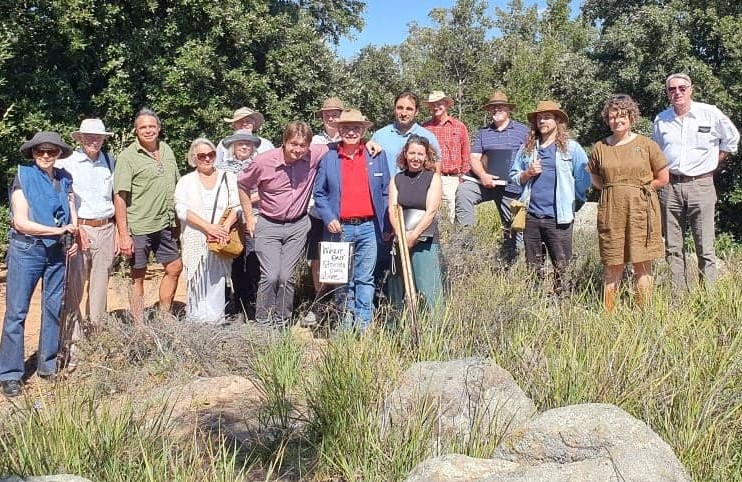
Ngambri man Shane Mortimer (in red shirt) with ACT Minister for the Environment Rebecca Vassarotti and supporters on the Ainslie Volcanics and Grassland site. Photo: Supplied.
Doma Group has been given the all clear for its The Foothills development on the former CSIRO site in Campbell after a new review of Aboriginal heritage concerns found the area was not culturally significant.
But the Ngambri man, Shane Mortimer, whose claims prompted the review has dismissed the consultant’s report as having no standing, and has vowed to continue his campaign to conserve the site, flagging possible court action.
Doma plans to build 244 dwellings on the Limestone Avenue site, containing 117 one, two and three-bedroom units and 95 townhouses. A separate application will be lodged for an additional 32 townhouses.
Mr Mortimer claimed, in June 2020, that rocky outcrops on the site were traditionally used for sacred men’s business, although there has been a dispute about whether it was more likely to be a women’s business place or a burial site.
He drew on independent consultants reports to back his claims and called for an investigation of the site.
Doma Group then commissioned a new cultural heritage study involving consultation with registered Aboriginal organisations in Canberra.
The previous investigation of the site’s Indigenous heritage took place when the Commonwealth sold the site in 2002.
The report found one Aboriginal site, an artefact scatter, had been recorded in the study area, and that Aboriginal representatives had identified a ‘pointer rock’ and a boulder containing a reported Aboriginal petroglyph of a ‘kangaroo’ motif.
But an analysis found the ‘pointer rock’ to be a natural formation, not a human-made feature, and that the marks on the boulder were made mechanically with metal tools when moved to their present location when Limestone Avenue was constructed around 1960.
The report also found the artefact scatter site had been assessed as having low archaeological significance due to the sparseness of artefacts and its disturbed context.
It also noted the disputed significance of Mount Ainslie, with some Aboriginal representatives maintaining it was a women’s site and that the study area itself does not have any particular cultural significance.
The report found the study area to be heavily impacted by the construction and subsequent demolition of the CSIRO buildings and car park, and that very little pre-European landscape or ground surface remains across the study area.

An artist’s impression of Doma Group’s The Foothills Campbell development. Image: Stewart Architecture.
The report concluded that the matters claimed as being of cultural significance did not meet the Department of Agriculture, Water and the Environment’s significance guidelines or the thresholds for Commonwealth or National Heritage listings, and the minister determined the land was not a significant Aboriginal area requiring special protection.
The department advised the National Capital Authority (NCA) that the previous Environment Protection and Biodiversity Conservation Act approval stood, and the NCA believes that key concerns raised during the public consultation period have now been addressed.
But Mr Mortimer said the report was racist and uninformed and would not stand up in a court of law.
“We have a raft of academics who have proven beyond doubt that the site has cultural significance,” he said.
Mr Mortimer said the petroglyphs required interpretation and he would be seeking to engage consultant archeologist and Aboriginal rock art expert Dr Robert Gunn to examine them.
He added the site’s endangered flora and fauna, and the boulders which have been the subject of geological study and with which his people have an enduring connection, also make it a site worth preserving.
A public meeting on the site at 10 am on Thursday, 18 March, will include a range of archeologists, geologists, Indigenous and planning experts in support of Mr Mortimer’s claims.
Doma Group’s general manager development, Gavin Edgar, said The Foothills project would include conservation and environmental offset measures, as well as respecting any Aboriginal artefacts found on the site.
“The design of the development always contained a rock garden with native landscape in part of the area in question, and this will be further developed with some of the boulders being repositioned in this area,” he said.
“We note that Mount Ainslie does have a strong Aboriginal history and there are surface artefacts present all over the mountain and surrounds.
“We are required to collect any visible surface artefacts prior to construction commencing and will reposition these in consultation with relevant Aboriginal community representatives. We also have a protocol that needs to be followed in case any further artefacts are uncovered during construction.”
Mr Edgar said civil construction works would commence in the second quarter of 2021 and take about two years to complete.
He said other environmental clearances for the land, specifically dealing with the golden sun moth and natural temperate grasslands on the site, had been previously obtained, with contributions being made to the Wandiyali Restoration Trust, which is creating the 400 hectare Wandiyali-Environa Conservation Area.
The Foothills will be officially launched in the near future and there has been strong market interest.
“Demand has been particularly strong since the start of this year and we are working towards having an onsite sales presence shortly,” said Mr Edgar.












